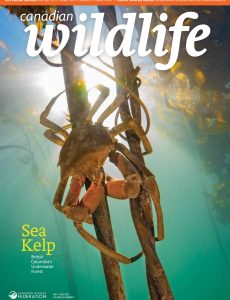
Canadian Wildlife Magazine May-June 2024
English | 48 pages | pdf | 8.94 MB
AFTER 15 YEARS AT CWF, THE PAST EIGHT AS CEO, I AM RETIRING. IT has been a pleasure and an honour to work with the many people so talented and passionate about their work for the conservation of Canadian wildlife.
Since our founding in 1962, the Canadian Wildlife Federation has maintained three main areas of focus: to educate Canadians on our country’s wildlife, the challenges it faces and the solutions possible; to support and do research on conservation issues; and to carry out large conservation programs across the country. That vision and balanced approach has remained front and centre during my time here. CWF’s approach to conservation is appreciated by Canadians from every province and territory, ethnic background and political stripe. Ours is a common-sense approach that brings together Canadians to find common ground, to express our shared appreciation for the beauty of nature, as well as the many benefits it provides society — economic, health, recreational and social.
Thanks to new technologies unimagined when CWF was just getting started, the organization now connects with more Canadians than ever. New communication tools have also been harnessed to create opportunities for us all to participate in citizen science, working with professional scientists to accomplish together more than otherwise possible. One result has been the exponential growth of CWF’s iNaturalist.ca platform. More than 200,000 Canadians (and climbing) upload their wildlife observations to this user-friendly portal and app. These sightings and reports enable researchers and scientists across the country to track biodiversity. And the more it is used, the more valuable it becomes. Species new to Canada have been discovered, and understanding has been improved of the range and populations of several species.
Canadian Wildlife magazine and Biosphère have kept us all informed of Canada’s fascinating wildlife and the challenges it faces. The magazine tells the stories as well of finding solutions, those implemented by CWF and by a great many other individuals and organizations all across Canada.
There has also been tremendous growth in the number of people heading outdoors to participate in our programs. Through the work of CWF education specialists, initiatives such as the WILD Outside program for youth ages 15–18 and the Canadian Conservation Corps for young adults, thousands of young Canadians volunteer their time and energy to conservation. Many of these participants report that these programs have changed their lives.
On behalf of our supporters, our conservation staff work to conserve a wide range of species at risk and help reduce the impacts of climate change. One example is our Rights-of-Way Habitat Restoration program, through which we work with hydro companies and municipalities to restore and connect habitat for pollinators on roadside tracts, utility corridors and solar farms. Another is our work to maintain native fish populations through our Fish Passage Restoration program, in which we remove culverts, damns, dikes and other human-made barriers to restore access to and connect stream habitat. To continue improving and expanding this
work, we also led the development of Canada’s new Aquatic Barrier Database. All this is complemented by advocating for stronger policies to support wildlife conservation, including better application of the Fisheries
A New Season
Act to help stop habitat loss, and stronger environmental responsibility incorporated in the Sustainable Canada Agriculture Partnership between the federal, provincial and territorial governments.
I am proud, too, of the important work we are doing to stop ship strikes and reduce the lethal rope entanglements so damaging to whales and other marine wildlife, while helping protect the livelihoods of those who harvest the sea. Among our initiatives to protect the North Atlantic right whale, CWF conservation specialists have been working directly with fish harvesters to
trial and refine new ropeless fishing gear that is safe, reliable and affordable and does the job. We also established the CWF Chair in Large Whale Conservation at Dalhousie University in Nova Scotia, for a researcher who works in all three of Canada’s oceans.
I am grateful for the people I worked with and the passion we shared. I appreciate our many board members, government, industry and not-for-profit partners from across the country with whom we worked on so many important projects. And to all, particularly CWF’s many thousands of donors, volunteers, participants, supporters and amateur conservationists, I say thank you for your support, passion and energy. You are the future of CWF, and I know it is in good hands.
From CWF
Rick J. Bates
CEO, Canadian Wildlife Federation
Download from: